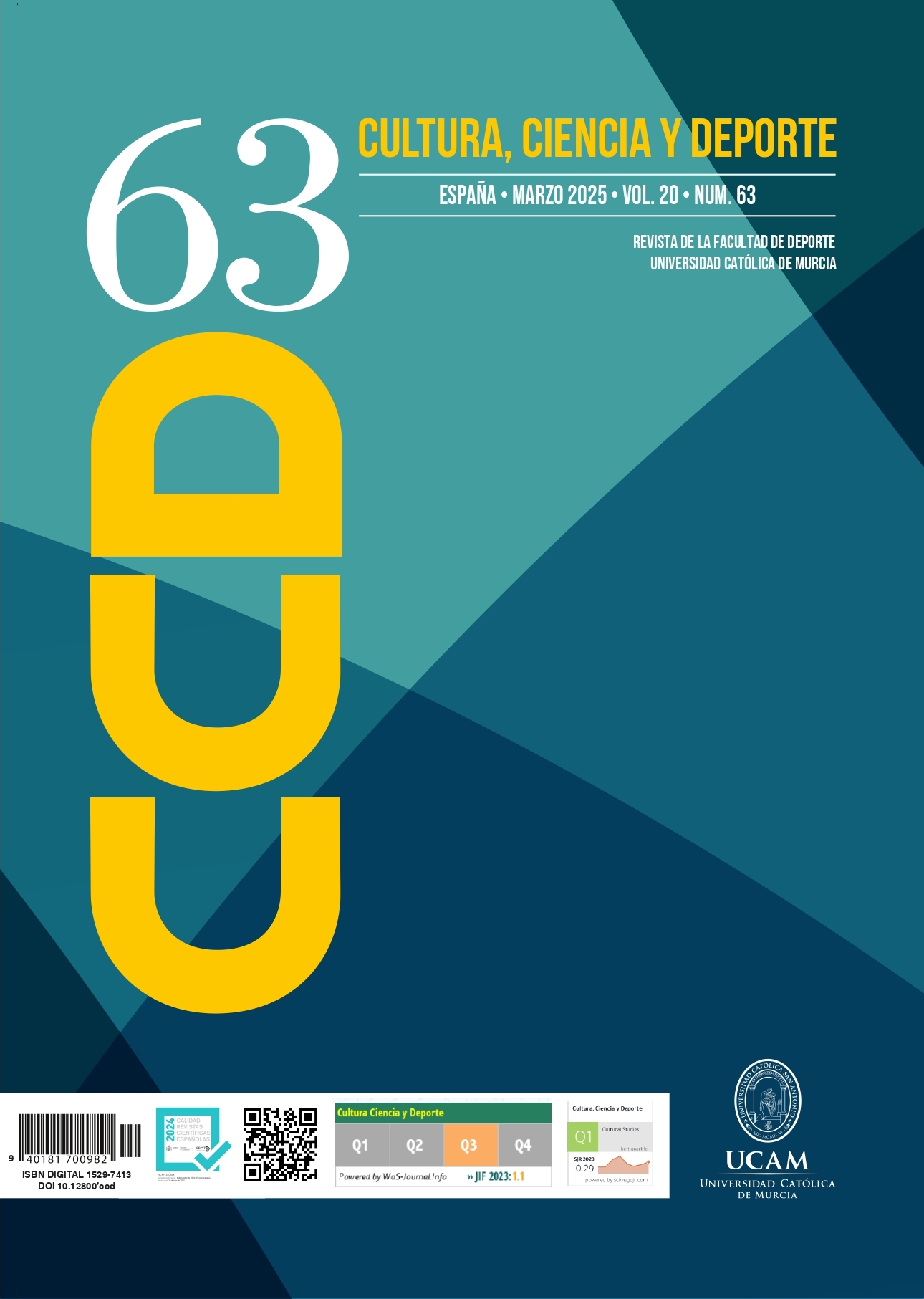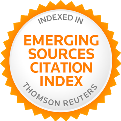Efectos de un Programa de Educación Física Basado en Kin Ball sobre el Índice de Masa Corporal y las Habilidades Físicas Básicas en Alumnos con Síndrome de Down
DOI:
https://doi.org/10.12800/ccd.v20i63.2211Resumen
Actualmente, la literatura científica establece que las personas con necesidades educativas especiales evidencian elevados niveles de sedentarismo. Asimismo, los deportes alternativos son conocidos por los numerosos beneficios que aportan. Esta investigación muestra el objetivo comprobar si un programa de iniciación deportiva del Kin ball mejora el efecto de las cualidades físicas básicas sobre el índice de masa corporal y la coordinación. Se ha desarrollado un estudio cuasi experimental con un diseño de un grupo pre-test-pos-test. La muestra está formada por 47 participantes con síndrome de Down. Para
recoger el índice de masa corporal se usó una balanza de bioimpedancia. Para evaluar los datos relacionados con la fuerza, flexibilidad, resistencia, velocidad y coordinación se ha utilizado la batería Eurofit adaptada para personas con discapacidad intelectual. Los resultados indican que el programa de intervención ha mejorado el efecto de la velocidad, coordinación, resistencia y flexibilidad sobre la coordinación y el índice de masa corporal. Como conclusión este estudio señala que el Kin Ball es
un deporte que ayuda a mejorar el desarrollo motor de estudiantes con necesidades educativas especiales.
Citas
Alesi, M., & Battaglia, G. (2019). Motor development and Down syndrome. In International Review of Research in Developmental Disabilities - State of the Art of Research on Down Syndrome (pp. 169–211). Elsevier.
Ballenger, B.K., Schultz, E.E., Dale, M., Fernhall, B., Motl, R.W., & Agiovlasitis, S. (2023). Health outcomes of physical activity interventions in adults with Down syndrome: A systematic review. Adapted Physical Activity Quarterly: APAQ, 40(2), 378–402. https://doi.org/10.1123/apaq.2022-0102
Boer, P. H., & Moss, S. J. (2016). Test–retest reliability and minimal detectable change scores of twelve functional fitness tests in adults with Down syndrome. Research in Developmental Disabilities, 48, 176-185. https://doi.org/10.1016/j.ridd.2015.10.022
Bürgi, F., Meyer, U., Granacher, U., Schindler, C., Marques-Vidal, P., Kriemler, S., & Puder, J. J. (2011). Relationship of physical activity with motor skills, aerobic fitness and body fat in preschool children: a cross-sectional and longitudinal study (Ballabeina). International Journal of Obesity, 35(7), 937-944. https://doi.org/10.1038/ijo.2011.54
Capellán Caraballo, R. L., & Ramírez Rodríguez, Y. J. (2023). Incidencia del índice de masa corporal en el desarrollo de capacidades físicas de estudiantes del Nivel Primario. MENTOR Revista de Investigación Educativa y Deportiva, 2, 761-780. https://doi.org/10.56200/mried.v2iespecial.6501
Castillo-Retamal, F., Albornoz-Pavez, C., González-Arellano, D., Flores-Cáceres, C., Becerra-Castro, K., Flores-Ferro, E., & Cordero-Tapia, F. (2024). Limitaciones y posibilidades de la clase de Educación Física y Salud en el desarrollo social de estudiantes con necesidades educativas especiales (Limitations and possibilities of the Physical Education and Health class in the social development of students with special educational needs). Retos, 53, 216–223. https://doi.org/10.47197/retos.v53.101617
Chastin, S. F. M., Palarea-Albaladejo, J., Dontje, M. L., & Skelton, D. A. (2015). Combined effects of time spent in physical activity, sedentary behaviors and sleep on obesity and cardio-metabolic health markers: A novel compositional data analysis approach. PloS One, 10(10). https://doi.org/10.1371/journal.pone.0139984
Cuesta-Vargas, A. I., Paz-Lourido, B., & Rodriguez, A. (2011). Physical fitness profile in adults with intellectual disabilities: differences between levels of sport practice. Research in Developmental Disabilities, 32(2), 788-794. https://doi.org/10.1016/j.ridd.2010.10.023
de Onis, M., & Lobstein, T. (2010). Defining obesity risk status in the general childhood population: Which cut-offs should we use? International Journal of Pediatric Obesity, 5(6), 458–460. https://doi.org/10.3109/17477161003615583 Decree 102/2023, de 9 de mayo, por el que se establece la ordenación y el currículo de la etapa de Educación Secundaria Obligatoria en la Comunidad Autónoma de Andalucía, Boletín Oficial de la Junta de Andalucía, 50 (2023). https://www.juntadeandalucia.es/boja/2023/90/3
Díaz-Amate, R., Alcántara-Moral, F., Torres-Luque, G., & Lara-Sánchez, A.J. (2015). Time and Gestural Structure of Kin-ball. Apunts. Educación Física y Deportes, 120, 36-42. https://doi.org/10.5672/apunts.2014-0983.es.(2015/2).120.05
Dustine, J.L., Gordon, B., Wang, Z., & Luo, X. (2012). Chronic disease and the link to physical activity. Journal of Sport and Health Science, 2(1), 3-11. https://doi.org/10.1016/j.jshs.2012.07.009
Hall, N., McDonald, G.K., Hay, J., Defries, D., & Pryece, R. (2016). Effect of Activity Type on Youth Physical Activity during Structured Activity Sessions. Health Behavior and Policy Review, 3(6), 546-556. https://doi.org/10.14485/HBPR.3.6.4
Hastie, P.A., Langevim F., & Wadsworth, D. (2011). Effects of Age and Experience on Physical Activity Accumulation During Kin-Ball. Research Quarterly for Exercise and Sport, 82(1), 140-144. https://doi.org/10.1080/02701367.2011.10599731
Kujala, U.M., Leskinen, T., Rottensteiner, M., Aaltonen, S., Ala-Korpela, M., Waller, K., & Kaprio, J. (2022). Physical activity and health: Findings from Finnish monozygotic twin pairs discordant for physical activity. Scandinavian Journal of Medicine & Science in Sports, 32(9), 1316-1323. https://doi.org/10.1111/sms.14205
Kyriazos, T.A. (2018). Applied Psychometrics: Sample Size and Sample Power Considerations in Factor Analysis (EFA, CFA) and SEM in General. Psychology, 9(8), https://doi.org/86856. 10.4236/psych.2018.98126
Lobenius-Palmér, K., Sjöqvist, B., Hurtig-Wennlöf, A., & Lundqvist, L.O. (2018). Accelerometer-Assessed Physical Activit and Sedentary Time in Youth With Disabilities. Adapted Physical Activity Quarterly, 351, 1-19. https://doi.org/10.1123/apaq.2015-0065
Loehlin, J.C., & Beaujean, A.A. (2017). Latent Variable Models: An Introduction to Factor, Path, and Structural Equation Analysis. Taylor & Francis. https://doi.org/10.4324/9781410609823
Maydeu-Olivares, A. (2017) Maximum Likelihood Estimation of Structural Equation Models for Continuous Data: Standard Errors and Goodness of Fit. Structural Equation Modeling: A Multidisciplinary Journal, 24(3), 383-394. https://doi.org/10.1080/10705511.2016.1269606
Melville, C.A., Mitchell, F., Stalker, K., Matthews, L., McConnachie, A., Murray, H.M., Melling, C., & Mutrie, N. (2015). Effectiveness of a walking programme to support adults with intellectual disabilities to increase physical activity: walk well cluster-randomised controlled trial. International Journal of Behavioral Nutrition and Physical Activity, 12, 125. https://doi.org/10.1186/s12966-015-0290-5
Mullor, D., Gallego, J., Cangas, A. J., Aguilar-Parra, J. M., Valenzuela, L., Mateu, J. M., & López-Pardo, A. (2017). Efectividad de un programa de actividad física en personas con trastorno mental grave / Effectiveness of a Program of Physical Activity in People with Serious Mental Disorder. Revista Internacional de Medicina y Ciencias de la Actividad Física y del Deporte, 17(67), 507-520. https://doi.org/10.15366/rimcafd2017.67.008
Nasuti, G., Stuart-Hill, L., & Temple, V.A. (2013). The Six-Minute Walk Test for adults with intellectual disability: a study of validity and reliability. Journal of Intellectual & Developmental Disability, 38(1), 31-38. https://doi.org/10.3109/13668250.2012.748885
World Health Organization. (2022). European Regional Obesity Report. Organización Mundial de la Salud. https://www.who.int/es
Pando, E. V. B., Valles, C. D., Contreras, M. O., & Lira, C. J. (2023). Actividad física en jóvenes con Síndrome de Down (hysical activity in people with Down Syndrome). Retos digital, 50, 415-420. https://recyt.fecyt.es/index.php/retos/article/view/94542
Ptomey, L.T., Lee, J., White, D.A., Helsel, B.C., Washburn, R.A., & Donelly, J.E. (2021). Changes in physical activity across a 6-month weight loss intervention in adolescents with intellectual and developmental disabilities. Journal of Intellectual Disability Research, 66(6), 545-557. https://doi.org/10.1111/jir.12909
Ramírez-Granizo, I.A., Ubago-Jiménez, J.L., Zurita-Ortega, F., Puertas-Molero, P., & Vílchez-Polo, I. (2020). Effectiveness of an intervention program on basic physical and coordination skills and its relationship with BMI in individuals with intellectual disability. Archives of Budo, 16, 235-243. https://archbudo.com/view/abstract/id/13243
Rosu, D., Enache, I.-S., Muntean, R.-I., & Stefanica, V. (2024). Effects of Kin Ball initiation: Pre- and post-pandemic impact on Palmar muscle strength, endurance, and coordination in non-athlete participants. Sports, 12(6), 158. https://doi.org/10.3390/sports12060158
Silva-Ortiz, A. M., Gamonales, J. M., Gámez-Calvo, L., & Muñoz-Jiménez, J. (2020). Beneficios de la actividad física inclusiva para personas con síndrome de Down: revisión sistemática. SPORT TK-Revista EuroAmericana de Ciencias del Deporte, 9(2), 81–94. https://doi.org/10.6018/sportk.454201
Simon, C., Palomo, R., & Echeita, G. (2021). The duty to promote an inclusive educational system: a phenomenological study on the assessment procedures of pupils with special educational needs in Madrid (Spain). International Journal of Inclusive Education, 28(6). https://doi.org/10.1080/13603116.2021.1968513
Skowroński, W., Horvat, M., Nocera, J., Roswal, G., & Croce, R. (2009). Eurofit special: European fitness battery score variation among individuals with intellectual disabilities. Adapted Physical Activity Quarterly, 26(1), 54-67. https://doi.org/10.1123/apaq.26.1.54
Tenenbaum, G., & Eklund, R.C. (2007). Handbook of Sport Psychology. Wiley.
Vílchez-Polo, I., Ramírez-Granizo, I.A., & Ubago-Jiménez, J.L. (2019). El SLOC, como nuevo deporte inclusivo: Una propuesta didáctica. ESHPA - Education, Sport, Health and Physical Activity, 3(3), 324-335. https://digibug.ugr.es/handle/10481/58331
Yang, W., Wong, S.H.S., Sum, R.K.W., Sit, C.H.P. (2021). The association between physical activity and mental health in children with special educational needs: A systematic review. Preventive Medicine Reports, 23, 101419. https://doi.org/10.1016/j.pmedr.2021.101419
Zurita-Ortega, F., Ubago-Jiménez, J.L., Puertas-Molero, P., Ramírez-Granizo, I.A., Muros, J.J., & González-Valero, G. (2020). Effects of an Alternative Sports Program Using Kin-Ball in Individuals with Intellectual Disabilities. International Journal of Environmental Research and Public Health, 17(15), 5296. https://doi.org/10.3390/ijerph17155296
Zurita-Ortega, F., Ortiz-Franco, M., Ubago-Jiménez, J. L., González-Valero, G., Alonso-Vargas, J. M., & Melguizo-Ibáñez, E. (2024). Kin ball to promote the motor development of students with special educational needs: effects of an intervention programme. Sport Sciences for Health, 20, 377–386. https://doi.org/10.1007/s11332-023-01104-5
Publicado
Cómo citar
Número
Sección
Licencia
Derechos de autor 2025 Creative Commons Attribution License

Esta obra está bajo una licencia internacional Creative Commons Atribución-NoComercial-CompartirIgual 4.0.
Los autores que publican en esta revista están de acuerdo con los siguientes términos:- Los autores conservan los derechos de autor y garantizan a la revista el derecho de ser la primera publicación del trabajo al igual que licenciado bajo una Creative Commons Attribution License que permite a otros compartir el trabajo con un reconocimiento de la autoría del trabajo y la publicación inicial en esta revista.













